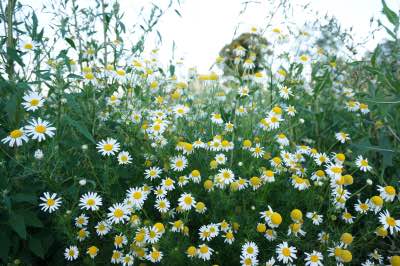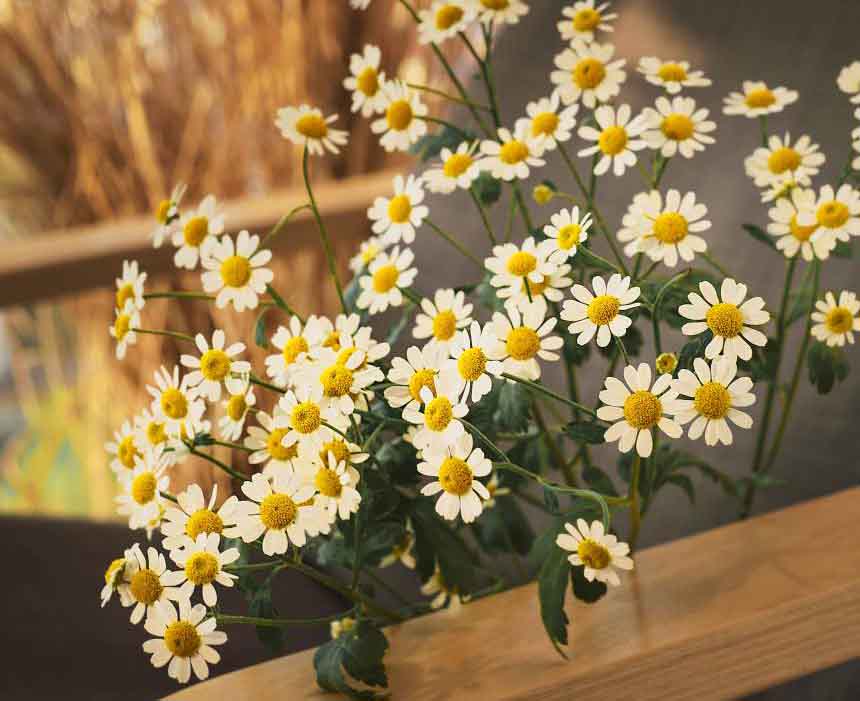Chamomile is a favorite plant among gardeners due to its pretty, aromatic flowers and effortless care requirements. Though it can be added to any outdoor garden, growing chamomile indoors ensures a consistent supply of edible parts for meals or beverages. They are also perfect for those looking for an attractive addition to their home. If you’re interested in learning how to start growing chamomile indoors, the following sections can help you get started.
Chamomile Overview
Chamomile is a European member of the daisy family, featuring blooms that sport pure white petals surrounding a fuzzy-looking yellow center. The pretty flowers offer more than aesthetic appeal since they also have a delightful fragrance and attract bees and butterflies when grown outside. Indoors, the plants add a cheerful touch to any space. Chamomile is a popular ingredient in teas, so it’s perfect for starting a herbal tea garden, but is also used in other aspects of cooking as well.
- Chamomile is an easy and fast-growing plant making it a popular choice for both indoor and outdoor gardens.
- Many people utilize the flowers to make teas and in cooking
- Chamomile likes a medium amount of light, shoot for 6+ hours per day
- Chamomile does best in moderate temperatures but can survive just fine in higher temperatures as well. Opt to mist the plant as the temperature rises to help protect it from the heat.
- This is a drought-tolerant plant that doesn’t like overly wet soil. Water sparingly. It also doesn’t like too much humidity.
- You can harvest the flowers once they’re fully open by snipping them off. Regular harvesting helps encourage future growth.
Varieties
Several chamomile varieties grow around the world, though only two are commonly grown in home gardens. German or wild chamomile, formally known as Matricaria chamomilla, is the most popular for making herbal tea. Chamaemelum nobile, also called Roman, English, or garden chamomile, is a great option for indoor gardens due to its compact size. Roman chamomile is also quite aggressive, so restricting it to pots prevents it from spreading too far.
Though both options have similar looks and edible portions, the German variety is slightly less bitter. It also produces more blooms, so if you’re using the plant for beverages and meals, you may want to stick with it over Roman chamomile. If you only want the plant for its aesthetic appeal, the Roman plants offer a stronger fragrance. In either case, the care is the same.
One more thing to note is that Roman chamomile is more compact and easier to grow in containers. If you’re going to try the German variety, then start with a slightly larger container to accommodate its size.

German Chamomile
Great flavor that is less bitter than other varieties. Does grow quite large though, so prepare a larger pot for optimal growth.
German Chamomile Seeds
Roman Chamomile
Slightly less flavorful than the German varietal, but more fragrant. Grows more compact so is easier to grow indoors
Roman chamomile SeedsPlanting/Soil
You can start your chamomile plants from seeds, sprinkling them over moist soil and pressing them gently into the dirt. They need light to germinate, so don’t bury them, follow the depth guide on the seed packet. Place them on a windowsill where they’ll receive plenty of sunlight and keep the soil moist by misting daily.
I personally enjoy starting my chamomile from seeds as I find it an easy plant to do so. They also germinate quickly, usually in about 2 weeks, so there’s not a long waiting period.
You can also start chamomile from a seedling. This lets you enjoy those blooms a bit quicker as you won’t have to wait for the germination period. You can place the starter plant in any pot at least 6 inches deep and 12 inches wide to give the roots room to spread. As noted, if growing the German varietal, then look for a 16-inch pot as this variety grows much larger. The container should also have drainage holes to release excess moisture. Clay pots are a great choice here, but any material will do.
As for the soil, chamomile isn’t overly picky. The plants prefer rich, organic soil, though I’ve had no issues with regular potting soil. Go with a commercial, all-purpose potting soil and you should be fine. Poor soil may cause floppy stems, though, so the better the soil, the happier chamomile will be.
Lighting
For a thriving plant producing plenty of flowers, chamomile requires at least 6 hours of sunlight each day. It can survive with less if necessary but don’t expect an abundance of blooms when limiting its light source.
For a happy plant, place it near a south-facing window, using sheer curtains to soften the sun’s rays during the summer months. Doing so protects the blooms from burning when the sun is at its hottest. You can also place your plant near an easterly-facing window without curtains for the same effect.
Chamomile can be encouraged to grow during the winter, but you’ll have to keep up the light requirements. This can be difficult if you live in an area with distinct seasons as the sunlight will typically be less intense during the cooler months. The solution is to supplement with a grow light. Adding a few hours of artificial light per day can help keep your plant growing during these dark and dreary months.

Tip
Grow lights are often less intense than natural light so run it for more hours than you would if the light was natural. A good rule of thumb is to run a grow light for 1.5-2 times the amount of time you’d provide natural light for.
Water and Feeding
Chamomile doesn’t require a lot of water, though its needs change as it grows and depending on the temperature. Young plants require about an inch of water each week. Older plants are more tolerant to drought, so allow the soil to dry between moderate watering. The best method is to feel the top 2-3” of the soil and water when it’s dry.
During the summer, if your home tends to be warm, you may need to add water more frequently, though not more than once a week. If you’re concerned about water, but don’t want to overwater, you can lightly mist the plant daily. This helps add moisture that will protect your plant from the heat without risking overwatering.
Feeding chamomile isn’t a requirement since the plant gets all the nutrients it needs from the soil. The plant rarely needs fertilizer, so only use it if the chamomile is fading and you can’t bring it back with sunlight and moisture. Too much fertilizer reduces the foliage and weakens the flavor of the blooms, so minimal usage is best.
If you deem feeding is needed, then opt to use compost or similar organic fertilizer if possible. If not, then dilute down a commercial fertilizer to reduce its intensity.
Temperature and Humidity
For a thriving indoor chamomile plant, home temperatures between 60 and 72 degrees Fahrenheit are best. Despite its preference for such moderate temperatures, the plant can handle temperatures reaching almost 100 degrees F. As noted above, regular misting can help protect your plant as the temperature rises.
Despite its love of heat, chamomile despises humidity. It’s a drought-tolerant plant, preferring dry conditions, so keep your home humidity levels at normal or lower levels if possible when growing chamomile indoors.
Pruning
Chamomile doesn’t require regular pruning, but there are times when it is essential. For instance, if the stems become leggy or spindly, you may want to trim them. Using sterilized scissors, cut each one to a height of about 4 inches above the soil line. If you want the plant to produce more flowers, trim the stems after harvesting the first blooms. Doing so encourages lush growth, giving you more edible parts to pluck for fresh tea or to dry for future use.
Harvesting Chamomile
The best time to harvest chamomile flowers is when they are fully open. To do so, take hold of the stem and pluck the blooms with your free hand, breaking it loose right beneath the flower. Leave as much of the stem as possible to encourage new buds. Once the flowers are free, you can use them for teas or add them to your favorite dishes. The flowers can also be placed on a tray for a week to dry for future use. Stored these dried flowers in a cool, dark, and dry place in an airtight container.

Tip
Stored property, dried chamomile can last for up to a year and still retain its freshness.
Growing Chamomile Indoors
Growing chamomile indoors is an easy task since the plant is relatively hardy and isn’t overly picky about its conditions. With the proper care, the pretty flowers will make a fantastic addition to any garden. Their edible pieces are a bonus, giving you plenty of blooms for your favorite dishes or beverages.
Frequently Asked Questions
Is chamomile susceptible to pests?
Chamomile is generally safe from most pests when grown indoors, though aphids and thrips may feed on the plants. If these are spotted on your indoor plant, gently wash the leaves and stems using water or treat them with insecticidal soap.
Are all chamomile parts edible?
No, not all parts of the chamomile plant are edible. Only the flowers, buds, and leaves should be used for tea and cooking. The stems and roots have a bitter flavor and aroma that isn’t enjoyable to humans.
What can you use chamomile for?
Chamomile has several uses. Harvest the edible parts for teas or when cooking. Steeped flowers make helpful steam inhalations for colds or other respiratory issues. Chamomile can also be used for oils, ointments, creams, compresses, or baths. The plant has anti-bacterial, anti-inflammatory, and calming effects, so it is a popular natural remedy for various ailments.







